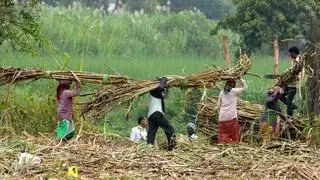The last century saw the advancement of an intensive agriculture production system, fuelled by consumption driven economics, that has led to deep social and ecological consequences. While Green Revolution marked the beginning of growth of industrial agriculture in India, the success triggered a deterministic transformation of a fairly diverse landscape of the country from 1960s to this date.
One such region is the Central Indian Tribal Region (CITR), which holds significance, as the key poverty-stricken area. This has been the focus of development, discourses and disconnected initiatives in the country for many years. Despite the public and private efforts, this region continues to lag behind on most development indicators.
Chronic poverty region
The CITR region is known for the rich concentration (and co-existence) of forests and tribal (indigenous) population. A home to approximately 50 per cent of India’s tribal population and 30 per cent of India’s forests, the region is a mosaic of agriculturally-based livelihood systems with some living a subsistence lifestyle from forests and farms with very less government and market penetration.
On average, despite the rich natural resources, the region witnesses chronic poverty with a monthly household income between ₹7,000 to ₹8,500 (about $100) against a national average of ₹23,000 (about $300).
With an average land ownership of 0.68 hectares, 30 per cent of the above income comes from farming, and the rest comes from wage labour, forest produce collection and remittances. Where agriculture employs 80 per cent of rural women, the commercialisation of agriculture has deprived them of access to new knowledge systems, finance and market systems, disempowering them from their traditional roles.
As per reports and estimates, agriculture has the highest estimated female labour force participation of around 62.9 per cent. Thus, there is an increased need for training and empowering women, to enhance the food production of the households, through systematic interventions.
Recurring issues
There is also a need to introduce high-yielding varieties (HYV) of paddy, to ensure food sufficiency for families. Continuous engagement with paddy intervention, like introducing new varieties of paddy seed according to land types, providing handholding support to farmers, building capacities of farmers on SRI, and improved methods, diseases, and pest management can make them food sufficient.
One of the issues which keep surfacing time and again, is the area under vegetable cultivation which does not increase in these remote areas. There was a market saturation due to high influx of vegetables from Western and Southern states and the local farmers could not compete with them in the market. During 2008-09, an approach like Agriculture Production Cluster (APC), which was based on market demand and mapping the critical gaps in market, proved to be one of the most innovative ways to bring women as a ‘Farmer’ to this sector.
Crops like pulses, oilseeds, and millets were also included in the intervention which have high nutritional value. Kitchen gardens were demonstrated by the field teams to address the nutritional importance of the families. While organisations such as PRADAN gained vast execution experience with the APC approach, there is a need for more such organisations to come forward and expand this approach. There is also an emerging need to shape the APCs as a formal institution for marginalised farmers.
There is also a need for the SHG (Self Help Groups) to come forward, as they play a critical role in farmer’s mobilisation, credit linkage, and monitoring of activities. Under sectoral interventions, different sectors and sub-sectors are identified, and end-to-end support is given to farmers with the support of AEs and FPOs.
If NGOs, SHGs, state governments and all others come together and collaboratively work together with innovative ideas and programs, this agriculturally rich Central India Tribal Region (CITR), can come out of poverty and ideally become a self sufficient region in the times to come.
The author is Integrator (Resource Mobilisation, Partnerships & Communications) at PRADAN.







Comments
Comments have to be in English, and in full sentences. They cannot be abusive or personal. Please abide by our community guidelines for posting your comments.
We have migrated to a new commenting platform. If you are already a registered user of TheHindu Businessline and logged in, you may continue to engage with our articles. If you do not have an account please register and login to post comments. Users can access their older comments by logging into their accounts on Vuukle.